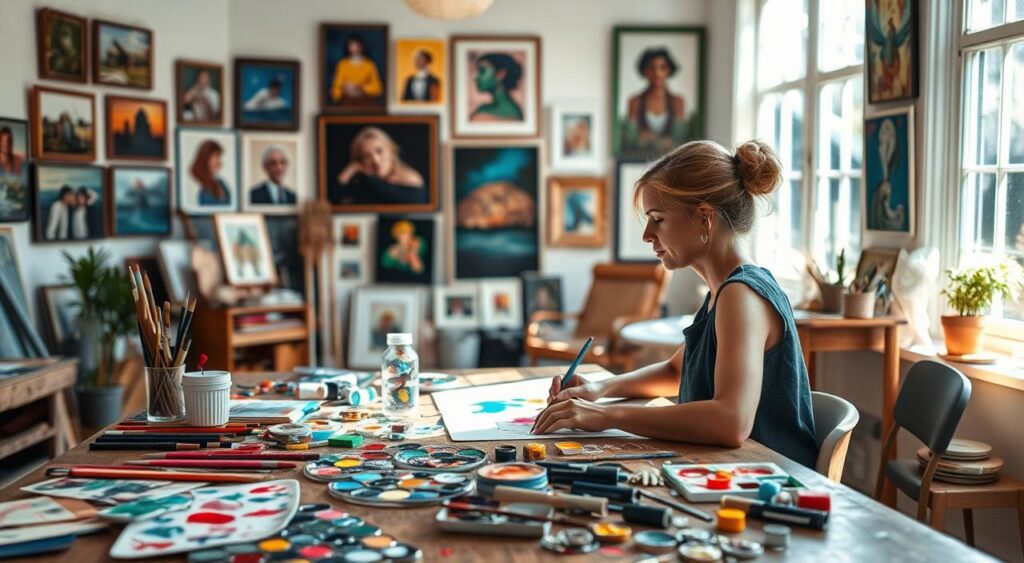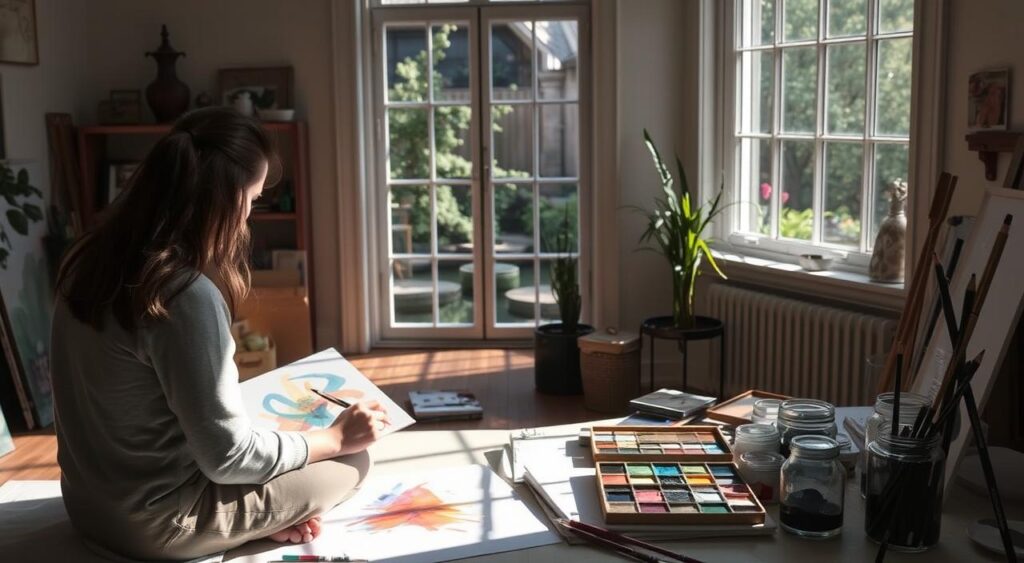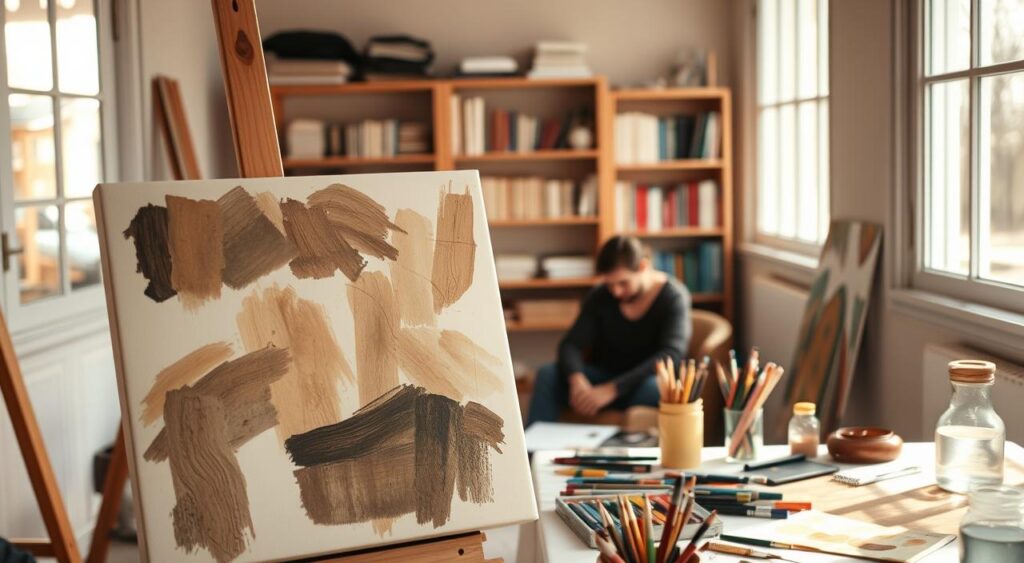Art therapy provides a special way for people to benefit from art therapy by facing the emotional pain of loss through creative expression. It uses drawing, painting, and sculpting to express feelings that are hard to put into words. This form of therapy helps individuals express emotions and find personal healing, offering a positive way to handle the deep sadness and disruption grief brings.

Introduction to Art Therapy
Art therapy is a therapeutic approach that harnesses the creative process of making art to enhance emotional, mental, and physical well-being. It is a valuable tool for individuals seeking to process and understand their emotions, and can be beneficial for people of all ages. Art therapy provides a safe and supportive environment where individuals can express their feelings and emotions through various art forms, including visual arts, music, and writing.
Understanding the Basics
The basics of art therapy involve the use of creative activities to promote emotional healing and self-expression. This can include drawing, painting, sculpting, and other forms of artistic expression. Art therapists are trained professionals who support individuals through the creative process, assisting them in exploring their emotions and gaining deeper insights into their experiences. The goal of art therapy is to provide a supportive environment where individuals can express their feelings and emotions, and work through challenging experiences.
Historical Context and Evolution
Art therapy has a rich history, dating back to the early 20th century. It evolved from the work of psychologists and artists who recognized the therapeutic potential of creative expression. Over time, art therapy has developed into a distinct form of therapy, with its own theories, practices, and techniques. Today, art therapy is used in a variety of settings, including hospitals, clinics, and private practices, and is recognized as a valuable tool for promoting emotional healing and well-being.
Key Takeaways
- Art therapy for grief helps in expressing emotions that are challenging to verbalize.
- Engaging in art activities like drawing and painting can provide emotional insight and healing.
- Grief counseling through art offers a constructive outlet for dealing with profound sadness.
- Art therapy for grief aids in coping with the emotional aftermath of loss.
- Using different art mediums can help individuals externalize complex emotional experiences.
- The creative process in art therapy contributes significantly to emotional and psychological well-being.
Understanding Art Therapy and Grief
Art therapy combines creative activities, like making art, with therapy. It helps people face emotional challenges, like grief. Through art, people can express their feelings without talking. This helps them work through tough emotions.
What is Art Therapy?
Art therapy uses creative acts to help people deal with mental and emotional problems. It’s great for those in grief. This is because it lets them show feelings hard to put into words. Techniques like drawing, painting, and sculpture with various art materials help people let out their feelings in different ways. Art therapists often draw on their clinical experience to tailor sessions to individual needs.
The Role of Emotions in Grief
Grief brings many difficult emotions—sadness, anger, confusion, and denial. Art therapy, as a way of expressing these feelings, offers a safe and supportive environment. People can explore and let out their emotions.
Adding art therapy to the grieving process offers comfort and insight. This leads to deeper healing and emotional health, allowing individuals to gain insights into their grief.
Benefits of Art Therapy for Grief
Art therapy provides a special and powerful way to deal with grief’s complex feelings through artistic expression, offering key benefits for emotional healing. By doing artistic activities, people can express themselves, find relief, and become stronger.
Emotional Expression
Art therapy is great for expressing feelings without words. Grieving people often find it hard to talk about their feelings, making art a good option for reducing stress. Through art, they can show emotions like sadness, anger, or confusion. Through art, they can engage in emotional processing, which helps them understand and articulate their feelings.

Stress Relief
Art therapy is very good at stress reduction and lowering stress levels. Making art is a valuable tool that helps people focus and relax, taking their minds off grief. This gives them a peaceful place to start healing.
Building Resilience
Art therapy also helps people become more resilient. It teaches them to understand and deal with their grief better. Over time, art therapy interventions help them handle life’s changes and grow stronger emotionally. It leads to personal growth and resilience.
How Art Therapy Works in Grieving
Art therapy uses creativity to make grief feel lighter. When grieving, the art making process lets you explore and share tough emotions in your own way. It creates a safe space to deal with these feelings, giving you control and strength while processing emotions.
The Creative Process
The creative process in art therapy is calming and meditative. Activities like painting or sculpting involve repeated, soothing actions. These can help calm your mind and body. Focusing on creating allows emotional release in a controlled way, addressing various emotional states and helping individuals stay in the present moment. This helps manage grief better. By using art for healing, people can touch and see their emotions, making complex feelings more understandable.
Exploring Different Mediums
Trying different mediums is key in art therapy for grief. The type of medium used—be it watercolors, clay, or collage—greatly affects how emotions are shown. Each one of the art forms offers a unique way to express yourself and deal with grief, including the use of oil pastels for their vibrant and expressive qualities.
- Watercolors: Fluid and unpredictable, aiding in the release of blocked emotions.
- Clay: Malleable and grounding, allowing for a physical manifestation of feelings.
- Collage: Integrative and dynamic, helping to piece together fragmented memories.
| Medium | Benefits |
| Watercolors | Promotes fluid expression and emotional release. |
| Clay | Offers a tangible way to ground and shape emotions. |
| Collage | Helps in integrating and piecing together fragmented thoughts. |
By experimenting with different materials, individuals can discover the best ways to express their feelings. This promotes healing and self-understanding in a supportive environment.
Types of Art Therapy Techniques
Art therapy uses different techniques to help manage grief. It uses art to aid healing. We’ll look at ways of incorporating art therapy methods in therapy sessions.
Drawing and Painting
Drawing and painting let you draw and show your feelings in a direct way. In making art therapy, you put your emotions on paper or canvas. Choosing colors and making images helps handle grief better.
Collage and Mixed Media
Collage and mixed media mix things like photos, words, and various materials. This can show both emotional and physical pain, highlighting the complex sides of your memories and experiences, and helping to process negative emotions. Creating a visual story of your grief journey is possible with this method.
Sculpture and 3D Art
Sculpture and 3D art let you touch and work with materials actively. Using clay, wood, or other mediums in daily life can be very healing. This approach lets you shape your emotions into a physical form that is both revealing and soothing.

Art Therapy Settings for Grief
Art therapy for grief comes in many forms, all to help different needs. It includes grief counseling through art either by one-on-one sessions or in groups. Both ways offer great support to those dealing with loss, especially when combined with professional support. Both ways offer great support to those dealing with loss, especially when family members are involved in the process.
Individual Sessions
Personal sessions are a safe place for self-discovery. They focus on methods that meet your emotional and creative needs. This private setting lets you deeply explore your healing process and emotional state with art as a tool for processing grief.
The therapy may use different activities like painting or sculpture. These help you deal with your feelings in your own way.
Group Therapy Opportunities
Group therapy, on the other hand, brings people together. It creates a community where everyone supports each other’s healing journey. Activities like group art projects and grief counseling through art help everyone find comfort and understanding, making them feel felt and supported.
| Setting | Benefits |
| Individual Sessions | Tailored emotional and creative approaches; privacy; deeper personal exploration; varied artistic mediums. |
| Group Therapy | Community support; shared healing; collaborative art projects; mutual understanding. |
Finding a Qualified Art Therapist
Art therapy for bereavement is a powerful way to heal, but you need the right guide. It’s key to pick a qualified art therapist for your journey through grief. It’s key to pick a qualified art therapist who uses a therapeutic approach tailored to your journey through grief. We will tell you what to look for and questions to ask.
Credentials to Look For
Looking for art therapy services for grief? Make sure the therapist has the right credentials. They should be certified by groups like the Art Therapy Credentials Board (ATCB) or the American Art Therapy Association (AATA). Certifications like ATR or ATR-BC show they’re trained to help with loss and have substantial clinical experience.
Questions to Ask Potential Therapists
Before you choose a therapist, ask important questions to see if they fit your needs. Find out about their work with art therapy for bereavement and how they use art in sessions. Knowing their success stories helps you know what to expect.
Incorporating Art at Home
You don’t have to go to a professional to use art therapy for loss. Start exploring art therapy for grief at home with easy, mindful tasks in a safe environment.
Simple Activities to Start With
Start with simple steps like drawing your feelings or making abstract art of your emotions. You don’t need to be an expert in art for these activities. It’s about expressing yourself, not making a perfect art piece. Start with simple steps like drawing your feelings, making abstract art of your emotions, or engaging in finger painting.
Creating a Grief Journal
Keeping a grief journal is another good way to use art therapy for loss. In this journal, you can put your drawings, paintings, and collages. It’s a private place to show your feelings through art.
By documenting your feelings visually, you can see how your emotions change over time. Each piece of art in your journal can help you see your healing journey and process your feelings better.
Daily Life and Art Therapy
Art therapy can be incorporated into daily life in a variety of ways, providing a creative outlet for emotional expression and processing. By engaging in artistic activities, individuals can reduce stress, gain new perspectives, and develop a deeper connection to their emotions and experiences.
Integrating Art into Everyday Routines
Integrating art into everyday routines can be a simple and effective way to promote emotional healing and well-being. This can involve setting aside time each day to engage in creative activities, such as drawing, painting, or writing. It can also involve incorporating art into daily tasks, such as using colorful pens or pencils to take notes, or creating art while listening to music. By making art a part of daily life, individuals can cultivate a sense of creativity and self-expression, and develop a more positive and resilient mindset. Art therapy offers a versatile approach to emotional healing, and can be adapted to suit individual needs and preferences. Whether used in a clinical setting or as a personal practice, art therapy has the potential to bring relief, reduce symptoms of emotional pain, and promote overall well-being.
Success Stories: Art Therapy Impact
Many people have found art therapy helpful for dealing with their sadness, significantly impacting their lives. These success stories show how making art helps people in big ways. We learn why art therapy is key for supporting those in grief by sharing these stories.
Personal Accounts of Healing
Art therapy has helped many feel better while grieving. One person said painting made them feel like a heavy burden was lifted. Another drew their emotions to find clarity. These stories show the power of art therapy in healing. It lets people express feelings and heals in a special way.

Professional Insights
Experts see how art therapy really works. Art therapist Catherine Moon says it clearly helps people feel better. “Art starts conversations with oneself and others, making it easier to understand complex feelings,” she explains. These stories prove how art therapy changes our view on grief and mental health. It shows its many benefits. Art therapist Catherine Moon says it clearly helps people feel better, especially when sessions are focused on specific emotional challenges.
Challenges in Art Therapy for Grief
Art therapy helps those who are grieving, but it has its hurdles. One big issue is challenges in art therapy is when people can’t show their feelings. This might be because they’re emotionally blocked. One big issue is challenges in art therapy is when people can’t show their feelings, often due to negative emotion.
Emotional Blocks
Getting past emotional blocks in art therapy is key to healing. Sometimes, people find it hard to face and show their feelings. This can stop them from making progress. Those leading the sessions have special ways to help without pushing too hard.
Misconceptions about Art Therapy
Some people don’t try art therapy because they misunderstand it. They think you have to be really good at art. But that’s not true. What matters is making something, not what it looks like in the end. Clearing up these wrong ideas helps more people join in and heal better.
Art Therapy as a Complement to Other Treatments
Art therapy with traditional treatments helps tackle complex emotional problems. It makes use of both speaking and creating art. This fully addresses a person’s needs, leading to better healing from grief. It also enhances problem solving by fostering decision-making and overcoming challenges through the creative process.
Combining with Traditional Therapy
Art therapy fits well within regular therapy sessions. It adds to methods like cognitive-behavioral therapy (CBT) and talking sessions. Through art, people can share feelings they can’t easily put into words, making it a comprehensive therapeutic approach.
This mix helps therapists understand clients’ emotions better. It opens doors to treatments that are more tailored and work well.

Benefits of a Holistic Approach
A holistic view in grief therapy considers the whole person: mind, body, and spirit. Art therapy offers a way to express grief creatively. This is especially helpful for those who find it hard to talk about their feelings.
It also lowers stress and sadness while building strength. This improves a person’s overall happiness and emotional state. By merging art therapy with regular therapies, clients get a deeper, more detailed path through their grief.
Resources for Further Exploration
If you want to learn more about art therapy for grief, there’s a lot out there. You can find information that helps both people grieving and therapists. We will look at some top books, articles, online courses, and workshops below, focusing on the use of visual art in therapy.
Recommended Books and Articles
There’s a lot to learn from books and articles on art therapy for grief. Reading works like “Art Therapy and Grief” by J. Williams and “The Healing Power of Art” by I. McGregor is helpful. They explain how art can help people express feelings and heal, focusing on the role of emotion in the process. Plus, reading research in journals like The Arts in Psychotherapy shows studies and evidence. This boosts both your knowledge and how you apply it.
Online Courses and Workshops
Online courses and workshops make learning about art therapy more engaging. Sites like Udemy and Coursera have courses by experts. These courses talk about different art therapy techniques for grief, walking you through the therapeutic approach. They walk you through the art therapy process. Also, joining workshops by groups like the American Art Therapy Association offers practice. You get to learn directly from experienced therapists.
Conclusion: The Healing Power of Creativity
Art therapy taps into your deep feelings during tough times. It shows how art can help heal, proving that your recovery journey is unique. With every brush stroke or clay mold, you take steps towards healing your pain and finding your true self.
Embracing Your Unique Journey
The path through grief isn’t straight. Art therapy helps you see that your journey is your own. It’s different from other therapies since it values your personal way of expressing feelings. By drawing, painting, or sculpting, you start a journey of self-discovery and emotional healing.
Encouragement to Start Creating
Beginning art therapy for grief is a process that’s gentle and revealing. Start slowly, using materials that match your feelings and stories. The act of creating is itself an important step of self-care. It opens new paths to healing that talking can’t always do. So, dive into creating and let art’s healing power help you cope with grief.
FAQ
What is art therapy?
Art therapy is a type of therapy that uses art-making to help people. It helps folks express hard-to-say feelings, leading to healing and understanding.
How does art therapy help with grief?
In dealing with loss, art therapy lets people show and work through complex feelings. Drawing or sculpting, among others, serves as a way to express oneself, relieve stress, and find strength. These activities also facilitate emotional processing, helping individuals navigate their emotions related to loss.
What benefits does art therapy provide for grief?
With art therapy, people can express emotions without words, feel calmer, and face changes after losing someone. Art therapy is quite helpful, especially to reduce stress.
What mediums or techniques can be used in art therapy for grief?
Techniques like drawing, collage, and 3D art help with grief. They allow for emotional release and reflection on memories and feelings.
Where can art therapy for grief be conducted?
You can do art therapy one-on-one or in groups. Alone, you get a personal approach. In groups, you share and learn with others.
How do I find a qualified art therapist for grief?
Look for an art therapist with proper certifications and experience in grief. It’s good to know their therapy style and success stories, too.
Can I practice art therapy techniques for managing grief at home?
Yes. Starting with easy activities like drawing or making collages at home can help. A grief journal with your artwork is a great tool, too.

What are some personal testimonials or success stories about art therapy for grief?
Many say art therapy brought them comfort and understanding in grief. It helped them deal with their feelings and accept their loss.
What challenges might I face with art therapy for grief?
You might struggle to express yourself or think you’re not “artistic” enough. But art therapy is more about feelings than skill.
How does art therapy complement other traditional treatments for grief?
It adds to traditional therapy, offering more ways to talk about grief. This can make healing more thorough.
Where can I find further resources on art therapy for grief?
You can find books, articles, courses, and workshops to learn more. They offer great advice on using art therapy to heal.


